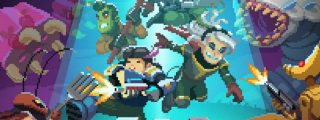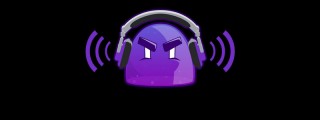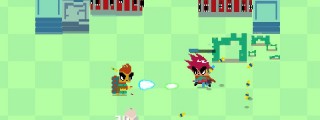Did you know that Power Rangers (or rather the show it spawned from) dates clear back to the late 70s? When I first heard the term “Sentai” I thought the same dirty things that are probably going through your head right now, but in reality the term refers to a group of television shows produced in Japan that would eventually become Power Rangers in the United States. If you’re a male in your mid to late 20s you probably have a soft spot for Power Rangers and the folks over Behold Studios are aiming to tap into that with their new tactical RPG, Chroma Squad.
Chroma Squad has been a long time coming. The game wrapped up its first Kickstarter clear back in 2013. Now after getting past several hurdles including a lawsuit from the makers of Power Rangers, the game has finally landed on Steam for the general public to consume and I’m happy to report that it was worth the wait.
The game follows a group of five stuntmen (and women) working in the world of Sentai (Power Rangers-esque) television. We begin with a very clever tutorial where you’re taught the basics of combat by following the orders of an overbearing director. By the end of the tutorial the stuntmen decide they can take no more and decide to strike out on their own by opening their very own television studio.
Chroma Squad is half tactical RPG (think Fire Emblem or XCOM) and half television studio simulator (think Tycoon games or XCOM’s base management component). You’ll spend the majority of your game time in combat so let’s get the simulation stuff out of the way first.
You start things out by customizing your actors and your studio. The level of freedom available to you is pretty great. You can name the studio, every member of your team, pick which actors will play which roles, and of course choose their ever important colors. You can also customize a lot of the game’s vocabulary including what catch phrases your characters yell when they transform or call their giant mech into combat.
So when you start out you’re given a contract that stipulates how many episodes you will produce and how many fans you can lose before your studio will be shut down. There are lots of different ways to spend your money in game. You can put more money into the studio itself, purchasing upgrades like health care for your actors, a vacuum cleaner to increase the item drop rate, or even just buying a new studio entirely. Ad agencies are available to you that will let you earn more money or build a bigger fan base. And of course then there’s your heroes themselves. You can either buy equipment in the game’s store or craft your own costumes and weapons using the random scraps of material you’ll find during battle.
For the most part managing your equipment and characters is a simple affair. When buying items from the store you can see before purchase which characters could use the item or already have something better equipped. One small complaint I have about crafting is that you have to make the item before you can actually see whether or not it would be of any value to your characters. This put me in a couple situations where I crafted an item only to find out that no one was actually able to use it.
The simulation segments are also where you’ll make the game’s story related decisions. In between battles you’ll receive emails that you need to answer. These can be from adoring fans or potential enemies. Sometimes a response will get you something simple like a new weapon or piece of armor, but other times your replies will have a stronger effect on the game’s overall narrative. These choices are what will eventually determine which of the game’s three endings you’ll be watching before the credits roll.
The game offers three difficulty options to choose from. The barebones difficulty lets players just experience the story, while the hardest difficulty puts a really heavy emphasis on the simulation side of things, making sure you’re picking the right upgrades and not operating outside your budget. The normal difficulty level has a somewhat slow curve for combat, but ultimately I never found myself even remotely close to having to shut down the studio, so if the simulation aspect is what’s exciting to you, you’ll want to go for the hardest gameplay mode.
When it comes time to actually shoot your episodes you’ll find yourself using a combat system very similar to what you see in XCOM. Your heroes can move around the board, attack enemies, or enter into a “teamwork” state. Putting a character in teamwork mode while they’re next to an enemy allows you to combo your attacks. Put three characters into teamwork and then send a fourth in to hit an opponent and you’ll do a powerful quadruple attack. If you send all five of your teammates into a single attack it will produce a powerful finishing move. Careful with that move though, if you pull a finisher before the end of an episode it will upset your fans. Teamwork can also be used to traverse the map faster, putting one team member into teamwork mode will allow them to fling other team members across the map to catch up to evading enemies or run away from danger.
Combat looks and feels great. It also plays out a lot like an actual episode of Power Rangers. Most of the time when you begin an episode your characters will not yet have transformed into Chroma Squad. Because the team heals up upon transforming you’ll usually want to spend the first few turns out of costume so that you can defeat a few enemies and absorb some free damage.
My one big hang up with the game’s combat is that there’s no option to undo movement once you’ve clicked. I understand not being able to take back entire turns, but the game has such a heavy emphasis on character placement there were often times where I’d misclick and accidentally move a character to a spot where they were useless, or maneuver a ranged character thinking he’d be able to hit an opponent only to find out I was short by one or two squares.
In most episodes when you’re done punching and kicking in person it will be time to have a giant robot battle. You’re able to name the team’s enormous mech as well as upgrade its different components during the simulation phase of the game. These fights start out simple enough, you only have two buttons: one to attack, and one to defend. Every time you attack you’ll increase a damage multiplier while also increasing your chances of a punch not connecting. Once you miss an attack it’s time for the monster you’re up against to retaliate. Early on I found myself just punching enemies to death and rarely going on the defensive, as the game progresses though you have to take a little more consideration into when to lay down pressure and when to back off.
Behold Studios is based out of Brazil and that often becomes apparent in the game’s translation and grammar. There aren’t an insane amount of typos and errors but there’s definitely enough that you’ll notice. Because Sentai is such a foreign concept I personally wasn’t bothered much by them, and actually saw them as a weird accidental bonus that made everything feel more authentic somehow. Nevertheless, if you’re the type of person to be bothered by this kind of stuff, you have been warned.
Chroma Squad is definitely one of my favorite games I’ve played this year. The Sentai aesthetic is creative and there’s a great sense of humor and happiness that’s pervasive throughout it. The game is chock full of pop culture references that may annoy some but I think even the greatest critic will smile at some point. There’s a few problems here and there, but despite that it’s really easy to recommend plopping 15 dollars down on this one.
This game was reviewed using retail code provided to us by the publisher.











